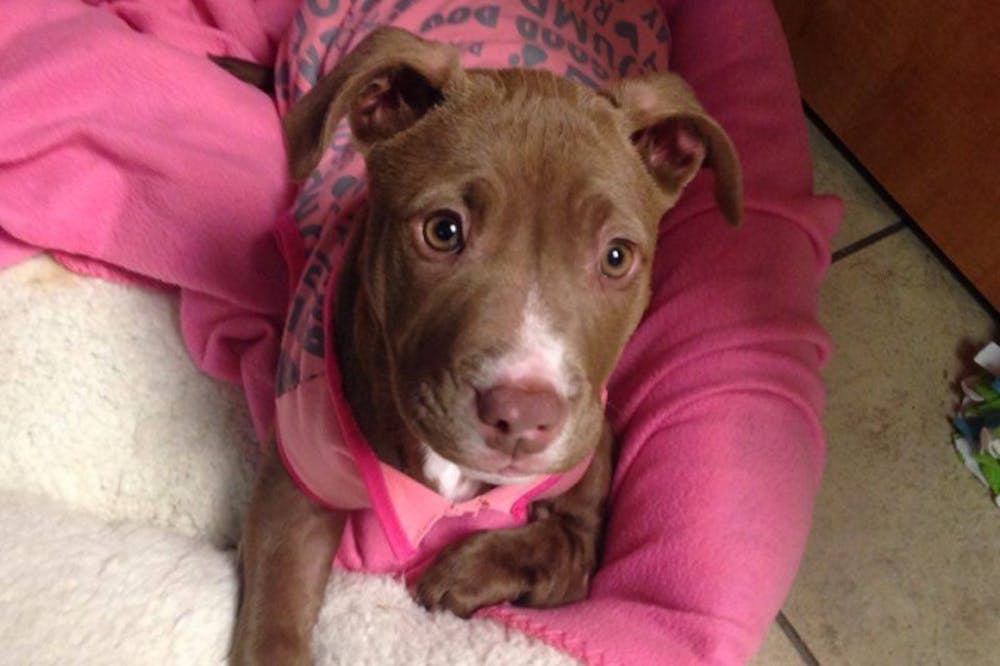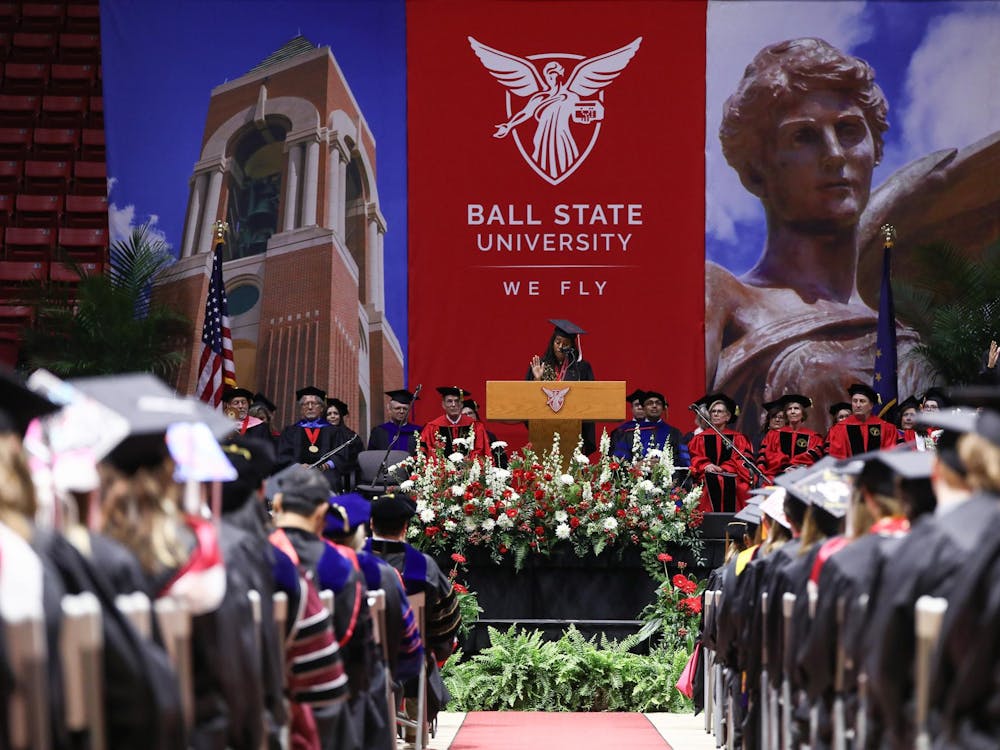For more information visit the shelter’s Facebook, www.facebook.com/MuncieAnimalShelter, or Muncie ARF’s Facebook, www.facebook.com/MuncieARF.
Current website promotions
ARF's Runway for Rescues Fundraiser
What: The fashion show will have its models strut their stuff alongside a primped-up pooch or fashionable feline. Buckle will provide clothing, while Amber’s Beauty School will do the makeup. Adoptable animals will be there.
When: 7 p.m. April 1
Where: Muncie Civic Theatre
Muncie Animal Shelter
What: Adoption event
When: National Adoption Week in May
Where: PetSmart
Muncie Animal Shelter's Facebook likes: 14,166
ARF's Facebook likes: 39,496
Ana, a 4-month-old pitbull puppy with a vibrant personality, hobbles through the hallways of the Muncie Animal Shelter, her tail wagging more rapidly with each visitor who stops to show her attention. The workers at the shelter say she is full of love and as a young puppy — she has an innocence to her. She hasn’t seen much of the world yet.
“She’s just the sweetest thing,” shelter office manager Ashley Honeycutt said.
Shelter workers discovered Ana digging through a dumpster near a home, her front left paw broken and hanging limp as she lifted it up. The nerves in her limb are so damaged that she has no feeling in it. She’s unable to walk or run normally, and because the leg has been broken for more than four weeks, it will most likely need to be amputated. The procedure to do so can be costly.
In an effort to raise money for the surgery, Honeycutt set up a GoFundMe for Ana on March 8, its link posted on the shelter’s Facebook along with a video of the puppy playing with some of the workers.
Two days later the video already had grabbed the attention, and the hearts, of more than 26,000 Facebook users. More than 11,000 of those users sat and watched the full video, and more than 350 of those video viewers “liked” the post.
And thanks to 17 different donors, the shelter raised $400 necessary for the surgery.
It’s just one of many success stories the shelter has seen thanks to its Internet reach, one that might not have existed if only a “lost and found” type of poster had been stapled to a telephone post.
“I’m comfortable saying 90 percent of our success here is because of social media,” Honeycutt said. “When people call and ask what we have available, I always direct them to the Facebook. That’s what we maintain regularly here.”
This is a new age for animal shelter advertising, and since the Muncie organization is a non-profit organization, funded by the city and its taxpayers, social media has served as its main source of marketing. The shelter’s staff consists of 10 workers, four full-time and six part-time, so when it comes to advertising, social media is the easiest way for them to ensure their animals are adopted. And with more than 14,000 Facebook users who like the shelter’s page, a simple story within a post can have a big impact, maybe even more than a costly newspaper ad.
Like the shelter, the Muncie Animal Rescue Fund (ARF) has a minimal amount of workers. Executive Director Vickie Bevans is the only full-time employee. Because of this, Bevans also utilizes her organization’s social media to get its animals into substantial living environments.
Gracie, a 10-week-old shih tzu/dachshund mix, is one of ARF’s rescue dogs. Suffering from a heart murmur, the puppy needed $2,500 for a corrective heart surgery. The organization didn’t have funding for the procedure, so Bevans and her team put out a post on the its Facebook.
They exceeded their goal by more than $5,000 in fewer than two weeks. The story itself reached national news outlets, including Inside Edition.
The organization responded on Facebook, “We just can't thank you all enough from the bottom of our hearts for the love and support that sweet little Gracie has received. … We are truly at a loss for words. Our appreciation is so deep. Thank you is simply not enough.”
THE LAST TO LEAVE AND THE FIRST TO COME BACK
For the animals that stay at ARF for more than a few months, social media reach helps ensure they connect with a loving family. Bevans and her staff put all their effort in getting those older, more fragile animals into a permanent home, preferably one that will appreciate it by showing love and kindness.
Dee McKinsey, the ARF communications director, said Facebook helps alleviate their problem with senior dogs and “boomerang animals,” ones that make their way back to their shelter when their adopters change their minds about having a pet.
“We tell that story [on social media], and hopefully we sink in with people so that they understand that when they adopt an animal, that’s your life, that it’s a responsibility,” McKinsey said.
Like ARF, the Muncie Animal Shelter uses its Facebook page to ensure no animal gets left behind. Honeycutt mentioned Domino, a dog with a deformed jaw she said “no one wanted.” At least, that was until a couple from Connecticut saw the Facebook post she shared and drove 13 hours in one day to adopt the dog.
It’s the type of story Honeycutt said wouldn’t have happened if social media didn’t exist.
And it’s not just the Muncie shelters that have seen social media’s impact on boomerang animals. Nationally, it’s a trend.
In Philadelphia, a pitbull mix named March broke the hearts of many when photographs surfaced online of him hiding in a corner, sad and staring at a wall.
The dog was supposed to be placed into a forever home, but the deal fell through, and he was forced back to the shelter, earning the label of a boomerang animal.
Workers with the Animal Control and Care Team in Philadelphia snapped pictures, hoping to evoke sympathy from the surrounding area and get March adopted. They sent them to various news outlets, including FOX 29, which later posted them on social media.
The story went viral. ACCT Philly received hundreds of emails from families wanting to take him in. Thanks to the attention the story received, March is being sent to a no-kill rescue facility, which will give him more time to find a loving family.
CONNECTING PETS TO FAMILIES
A “lost and found” poster might surface on the occasional bulletin board across the city, but the reach is limited to those within the area it is posted. A Facebook post, on the other hand, has potential to spread across a greater distance, which is why Honeycutt goes to the Internet first when she’s trying to connect lost animals to their worried owners. She says if the owner doesn’t see the animal, it is likely that a friend or relative will.
Even for those that don’t make it into the shelter, but rather to the homes of other local residents, their story still gets told. Honeycutt and other staffers share submitted posts from Facebook users, hoping the photos unite the owners to the families who find the lost pets.
The shelter’s Facebook page has a photo album specifically designed for this.
“I would say almost every lost pet that we bring in here, if we’re able to reunite them with the owner, it’s because someone has seen it on Facebook or it’s been shared,” Honeycutt said.
On March 16, the shelter posted about Bentley, a dog whose owners had been searching for him for weeks.
The short story pulled in more than 100 Facebook likes and 10 comments in fewer than four hours. A couple found the dog and immediately shared a picture with the shelter, which connected them with Bentley’s owners.
WHAT THE FUTURE HOLDS
Though the feedback is mostly positive online, there is a negative to having such a wide reach. Nikki Kirby, senior manager of ARF, said that too much of a following can create a bit of disorganization.
“Sometimes the problem is we get too much interest and then we get people upset,” Kirby said. “That’s the hard part. You get so much interest in one animal, and there are all these other ones, and they don’t want those.”
But workers at both ARF and the Muncie Animal Shelter said the benefits outweigh the drawbacks.
“If it weren’t for the community, [ARF] probably would not have survived this long,” McKinsey says.
Gracie, the shih tzu/dachshund mix from ARF, received her heart surgery and will be able to live longer than a year thanks to social media reach.
And Ana, the playful pitbull from the Muncie Animal Shelter, will soon be able to walk better because her cry for help was communicated through social media storytelling.
It’s that part of the job that keeps Honeycutt and her other staffers going.
“I can’t wait to be able to put, ‘This is Ana when we got her, and look at her now,’” Honeycutt said. “I try to focus on the end result. I always tell people if they adopt or if they foster, you’re saving two lives, the one you’re adopting, and you’re opening up a kennel for another one that needs it. It’s kind of like a revolving door, but it’s a good kind of revolving door.”





